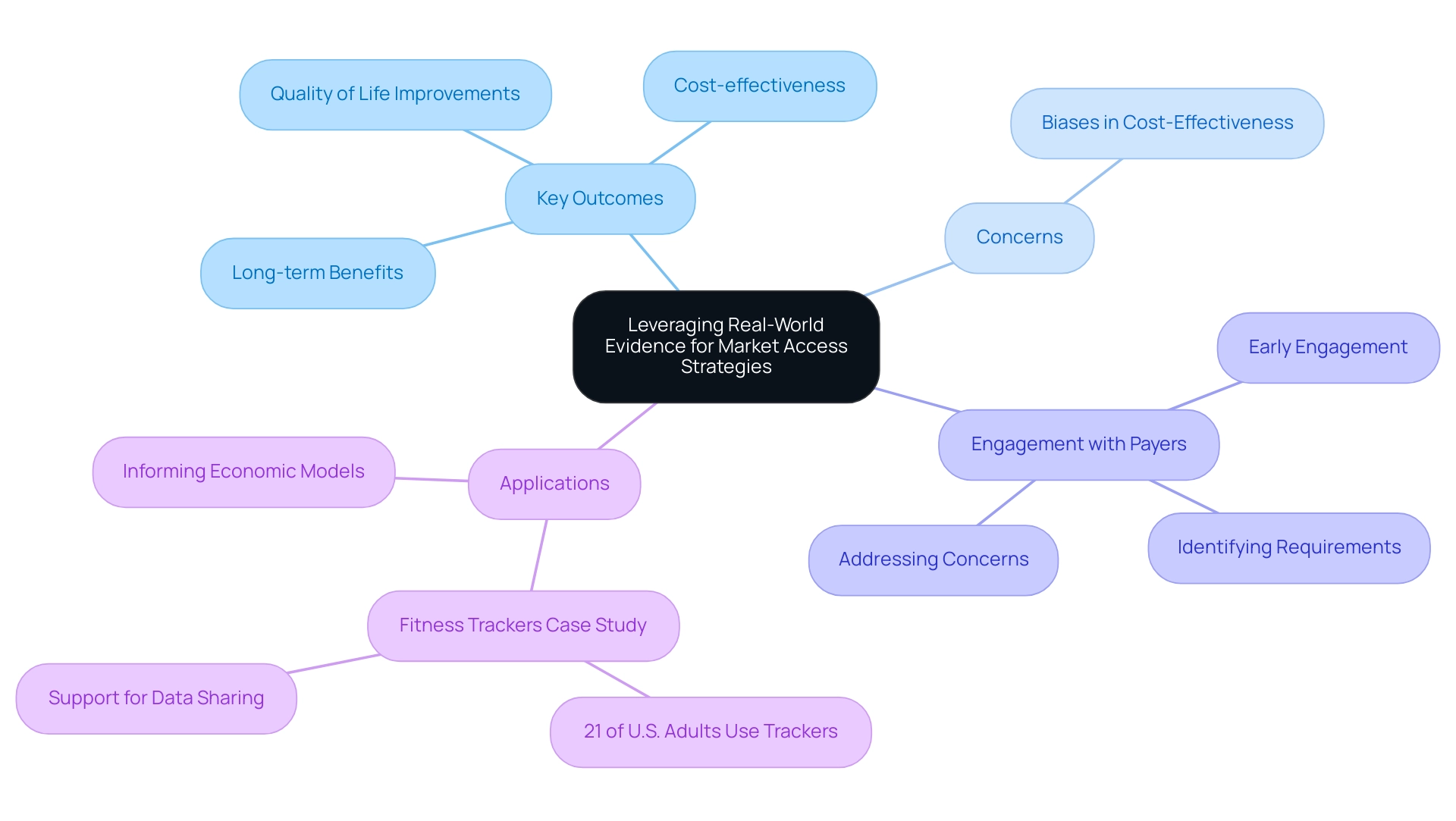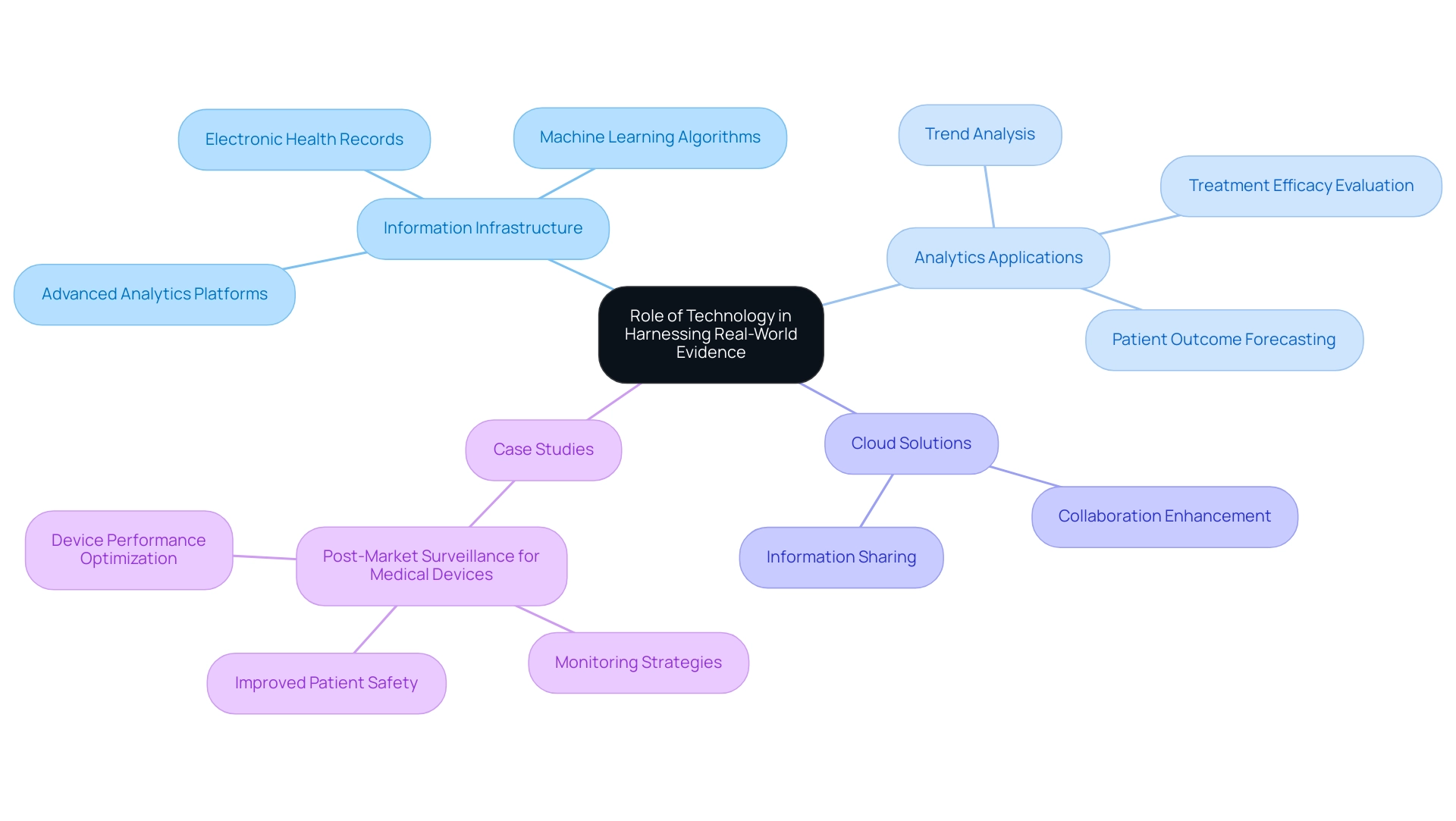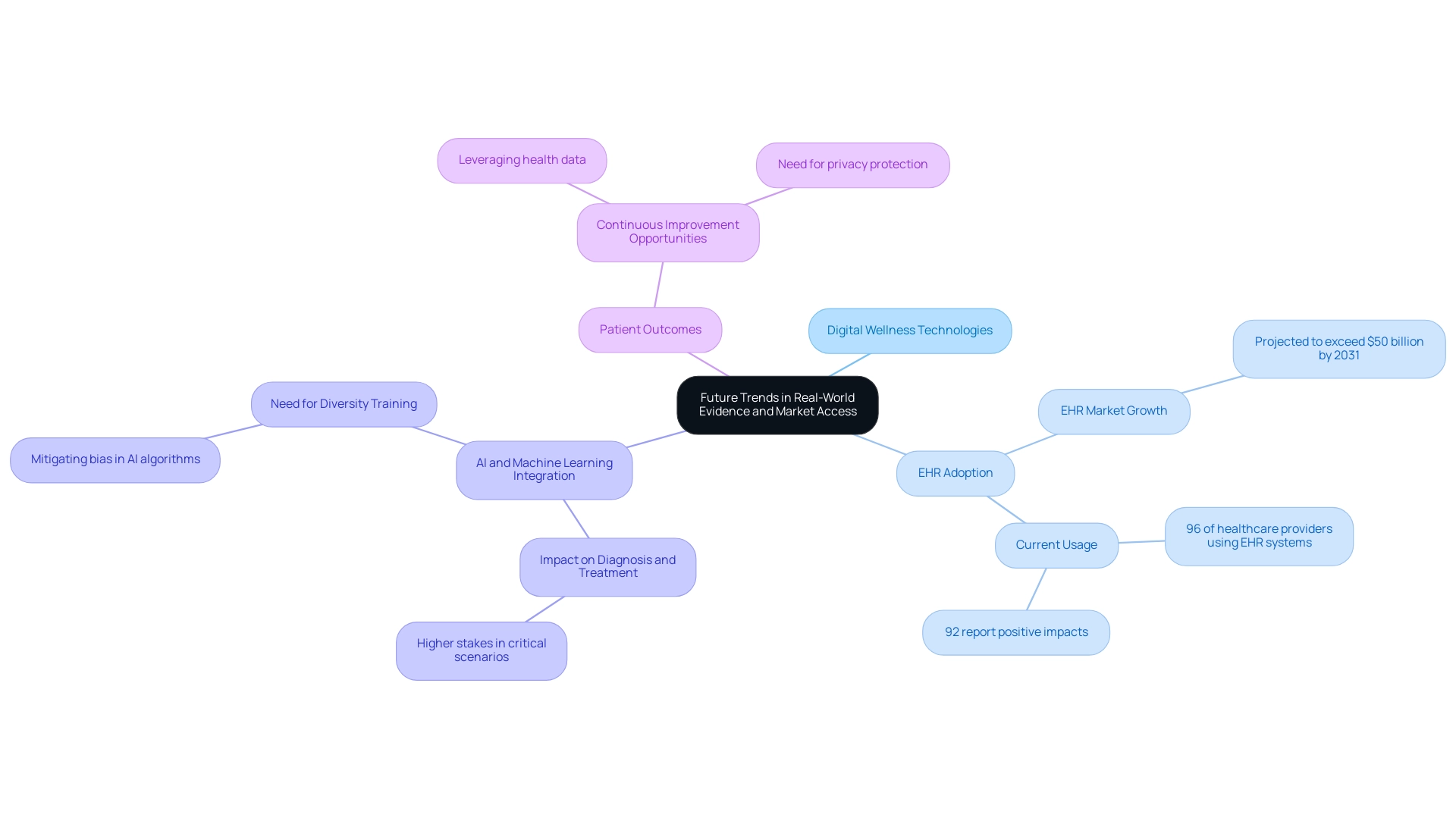Overview
The article focuses on the critical role of real-world evidence (RWE) in enhancing market access for healthcare products by providing insights into actual patient outcomes and treatment effectiveness. It emphasizes that integrating RWE into market access strategies allows stakeholders to better demonstrate the value of healthcare interventions, while also addressing challenges such as data security and regulatory compliance to foster acceptance and improve healthcare decision-making.
Introduction
The integration of real-world evidence (RWE) into healthcare decision-making is reshaping market access strategies, offering a wealth of insights derived from everyday healthcare practices. By utilizing data from electronic health records, insurance claims, and patient registries, stakeholders can gain a comprehensive understanding of treatment efficacy and patient outcomes that go beyond traditional clinical trials.
However, the path to effectively harnessing RWE is fraught with challenges, including:
- Regulatory complexities
- The need for robust data infrastructure
As organizations strive to navigate this evolving landscape, the emphasis on collaboration, technological advancements, and public trust becomes paramount. This article delves into the critical aspects of RWE, exploring its significance, the role of technology, and future trends that will influence market access in the healthcare sector.
Defining Real-World Evidence and Its Importance in Market Access
Real-world evidence (RWE) encompasses information collected from everyday healthcare settings, including electronic health records, insurance claims, and patient registries. This data reflects actual patient results and treatment patterns, providing insights that extend beyond the confines of controlled clinical trials. The Role of Real-World Evidence in Market Access is vital for stakeholders, as the integration of RWE into market access strategies enables them to grasp the effectiveness and value of healthcare interventions in practical scenarios.
A key challenge identified in RWE is related to:
- Security
- Awareness
- Coordination
- Adoption
- Format
- Assurance
With an occurrence of 1 (2.6%), highlighting the need for improvement in these areas. By utilizing RWE, companies can illustrate The Role of Real-World Evidence in Market Access by providing persuasive evidence to payers and regulatory agencies about the advantages of their products, thus enhancing patient results and aiding reimbursement choices. Moreover, the success of RWE relies on public awareness and trust; as the FDA states, "randomization is the key to prevent bias when allocating interventions by ensuring study groups are balanced for risk factors for the targeted result," highlighting the significance of methodological rigor in RWE studies.
Additionally, the case study titled 'Public Awareness and Trust in RWD' emphasizes that initiatives aimed at educating both healthcare professionals and the public about the advantages and risks associated with RWE are essential. These efforts are critical for fostering acceptance and supporting the future use of RWE in healthcare decisions, which will increasingly require collaboration among stakeholders to enhance data analytics capabilities and public health benefits.
Leveraging Real-World Evidence for Effective Market Access Strategies
To effectively leverage real-world evidence (RWE), organizations must understand the role of real-world evidence in market access by integrating it into their strategies and identifying the key results that are of paramount importance to payers. These outcomes include:
- Cost-effectiveness
- Improvements in quality of life
- Long-term benefits for patients
It is important to note that many studies have assumed 'no unobserved confounding' without justification, raising concerns about potential biases in cost-effectiveness estimates.
By utilizing RWE within economic models, companies can craft value propositions that resonate with stakeholders, showcasing the role of real-world evidence in market access and enhancing decision-making processes. For example, the case study on the adoption of fitness trackers shows that about 21% of U.S. adults consistently use these devices, which gather important information on physical activity that can be applied for medical research. A significant portion of Americans supports sharing this information for research purposes, indicating a growing acceptance of using health information for research.
Furthermore, as noted by industry expert George, reported differences in the application of RWE vary depending on the type of intervention and therapeutic area, underscoring the need for tailored approaches. Engaging with payers early in the product development process is essential, allowing companies to clearly identify requirements and proactively address any potential concerns. This proactive engagement ultimately streamlines access to products in the market and fosters stronger relationships with payers.
Additionally, The Role of Real-World Evidence in Market Access can inform economic models with real-world parameters, resulting in more accurate and relevant cost-effectiveness outcomes for real-world decision-making.

The Role of Technology and Data in Harnessing Real-World Evidence
The function of technology in utilizing real-world evidence (RWE) is essential, particularly in understanding The Role of Real-World Evidence in Market Access, as it enables organizations to gather, store, and analyze extensive information effectively. Investing in a robust information infrastructure—comprising electronic health record systems, advanced analytics platforms, and machine learning algorithms—is essential for deriving actionable insights from RWE. For instance, IBM Watson.
X information has been shown to reduce warehouse costs by up to 50% through workload optimization, underscoring the financial benefits of such investments. The Role of Real-World Evidence in Market Access is highlighted through the application of sophisticated analytics, allowing companies to discern trends, evaluate treatment efficacy, and forecast patient outcomes, which are crucial for shaping effective market access strategies. Furthermore, cloud-based solutions enhance collaboration and information sharing among stakeholders, enriching the RWE ecosystem.
As emphasized by Mansha Kapoor,
Discover how remote monitoring and wearable technology transform healthcare, enabling real-time information, improving chronic disease management, reducing hospitalizations, and fostering proactive, patient-centered care with innovative solutions.
This transformative potential is evident in the case study on post-market surveillance for medical devices, which illustrates strategies for ongoing monitoring that improve patient safety and device performance. Such examples reinforce the necessity of technology investment in RWE information infrastructure, as they illustrate The Role of Real-World Evidence in Market Access by optimizing operational efficiency and supporting better healthcare outcomes.

Navigating Regulatory Challenges in Real-World Evidence Utilization
Navigating the regulatory landscape surrounding real-world evidence (RWE) is increasingly intricate and varies significantly across regions. In the United States, the FDA has taken steps to clarify its stance on the utilization of RWE, emphasizing The Role of Real-World Evidence in Market Access to inform regulatory decisions. Digital Health Technologies (DHTs) for drug development are recognized as essential in this context, offering innovative methods to collect and analyze medical information.
Moreover, with around 21 percent of U.S. adults regularly using fitness trackers, the amount of information available for health research is increasing, and 41 percent of Americans find it acceptable for these companies to share details for heart disease research. Adhering to Good Clinical Practice (GCP) standards is paramount for companies conducting RWE studies. This includes ensuring the quality and integrity of the collected information, securing necessary patient consents, and proactively addressing potential biases within the information collection process.
Kristin Kostka, Director of the OHDSI Center at Northeastern University’s Roux Institute, notes, 'In these high stakes, high reward situations where we’re looking to get therapies on market for groups that have a serious need, there’s a lot of interest.' Thus, comprehending these regulatory requirements is crucial for organizations seeking to understand The Role of Real-World Evidence in Market Access effectively while mitigating the risk of compliance issues. Our service capabilities, led by experts like Ana Criado, Director of Regulatory Affairs and CEO of Mahu Pharma, and Katherine Ruiz, a specialist in Regulatory Affairs for Medical Devices and In Vitro Diagnostics in Colombia, include:
- Feasibility studies
- Site selection
- Compliance reviews
- Trial setup
- Import permits
- Project management
- Reporting
These services are intended to guarantee adherence to regulatory requirements, with a particular emphasis on documentation and quality assurance plans that uphold integrity. The case study on Quality Recommendations highlights the importance of documenting quality assurance plans and coordinating with various vendors to ensure integrity and address quality challenges. By ensuring robust quality assurance plans and collaboration with data vendors, organizations can enhance data integrity and effectively support successful market access strategies, illustrating The Role of Real-World Evidence in Market Access.
Future Trends in Real-World Evidence and Market Access
The healthcare landscape is undergoing significant transformation, with several key trends poised to shape The Role of Real-World Evidence in Market Access strategies. A notable trend is the increasing adoption of digital wellness technologies, projected to propel the electronic record (EHR) market to exceed $50 billion by 2031. With 96% of healthcare providers currently utilizing EHR systems, these technologies are generating real-time RWE that can drive informed decision-making and improve patient-centered results.
Importantly, 92% of EHR users report positive impacts on their practice, emphasizing the effectiveness of these systems. Furthermore, the integration of artificial intelligence and machine learning into the analysis of RWE is set to revolutionize how insights are derived, particularly in high-stakes scenarios. As noted by Lin et al.,
when algorithms are used to assist in the diagnosis of diabetic retinopathy or the recommendation of a therapeutic approach to sepsis, the stakes are much higher.
This emphasizes the importance for stakeholders to prioritize diversity training to reduce bias in AI algorithms, ensuring fair solutions. Furthermore, there is an unexploited chance to utilize medical data for ongoing enhancement in wellness results, necessitating careful oversight to safeguard personal privacy. The continuing evolution of RWE will not only foster improvements in health outcomes but also underscore The Role of Real-World Evidence in Market Access, reinforcing the importance of equitable health solutions.

Conclusion
The integration of real-world evidence (RWE) into healthcare decision-making is not merely a trend; it is a transformative approach that enhances market access strategies and improves patient outcomes. As outlined in the discussions, RWE offers insights derived from actual healthcare practices, allowing stakeholders to evaluate treatment efficacy in ways that traditional clinical trials cannot. However, the successful implementation of RWE is contingent upon overcoming significant challenges, including:
- Regulatory complexities
- The need for robust data infrastructure
Moreover, the role of technology in harnessing RWE cannot be overstated. Organizations that invest in advanced data analytics and cloud-based solutions are better positioned to analyze extensive data sets, derive actionable insights, and ultimately enhance decision-making processes. The case studies presented highlight how innovative technologies and proactive engagement with payers can streamline market access and foster stronger relationships within the healthcare ecosystem.
Looking ahead, the future of RWE in market access is promising, with trends such as the increasing adoption of digital health technologies and advancements in artificial intelligence poised to revolutionize healthcare delivery. As the healthcare landscape continues to evolve, embracing RWE will be essential for stakeholders aiming to navigate this complex environment effectively. By prioritizing collaboration, public trust, and methodological rigor, the potential of RWE to improve health outcomes and inform strategic decisions will be fully realized, paving the way for a more effective healthcare system.
Frequently Asked Questions
What is real-world evidence (RWE)?
Real-world evidence (RWE) refers to information collected from everyday healthcare settings, such as electronic health records, insurance claims, and patient registries, which reflects actual patient outcomes and treatment patterns.
Why is RWE important for market access?
RWE is vital for market access as it helps stakeholders understand the effectiveness and value of healthcare interventions in real-life scenarios, enabling them to provide persuasive evidence to payers and regulatory agencies regarding the advantages of their products.
What are the key challenges associated with RWE?
The key challenges identified in RWE include security, awareness, coordination, adoption, format, and assurance, all of which need improvement for better utilization of RWE.
How can RWE enhance patient outcomes and reimbursement decisions?
By utilizing RWE, companies can provide convincing evidence to support the effectiveness of their products, which can lead to improved patient outcomes and informed reimbursement decisions.
What role does public awareness and trust play in the success of RWE?
Public awareness and trust are crucial for the success of RWE, as they foster acceptance of RWE in healthcare decisions and encourage collaboration among stakeholders to improve data analytics capabilities.
What outcomes are important to payers when integrating RWE into market access strategies?
Important outcomes for payers include cost-effectiveness, improvements in quality of life, and long-term benefits for patients.
What concerns have been raised regarding cost-effectiveness estimates in RWE studies?
Many studies have assumed 'no unobserved confounding' without justification, raising concerns about potential biases in cost-effectiveness estimates.
How can companies effectively use RWE within economic models?
Companies can use RWE within economic models to create value propositions that resonate with stakeholders, enhancing decision-making processes and demonstrating the role of RWE in market access.
What does the case study on fitness trackers indicate about public acceptance of health information for research?
The case study shows that about 21% of U.S. adults consistently use fitness trackers, and a significant portion supports sharing this information for research purposes, indicating growing acceptance of using health information for research.
Why is early engagement with payers important during product development?
Engaging with payers early in the product development process allows companies to identify requirements clearly and proactively address potential concerns, ultimately streamlining market access and fostering stronger relationships with payers.




